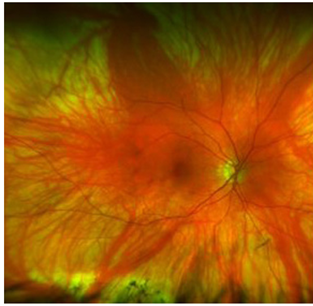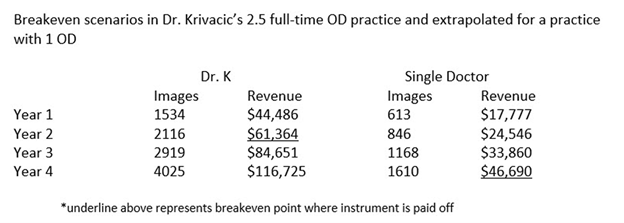How to Grow your Optometry Practice
As Optometry has evolved, the use of new technologies has become integral to optometric care by providing revenue and efficiencies that go right to the bottom line for practices that have made the investment.
Recently, five Optometrists took the time to discuss the most valuable technology investment in their optometry practice, their optomap device, and the competitive edge it provides.
One Instrument Generating $180,000 Annually
Thomas Arnold, OD, knows how an optometry practice is built by providing high-quality care to patients, and how that care can be greatly enhanced by the right technologies. Dr. Arnold was an early adopter of optomap imaging, his patients have always appreciated being able to see what the doctor is describing rather than trying to assimilate complicated medical terminology.

“Adding this technology to our practice helped to streamline our examination protocol, as images were captured during the preliminary evaluation and were ready for review during the examination with the doctor. In 2001, this created a “wow” factor that most patients had never experienced.”
When it comes to return on investment (ROI), Dr. Arnold charges patients for optomap in his practice with an average of 65 percent of patients opting in to receive the exam at an average of $44. As a busy practice with two doctors, the calculated revenue of approximately $180,000 per year more than covers the cost of the device.
optomap Benefits Patients and Provides Immediate ROI
Chris Butcher, OD, added optomap retinal imaging to his 15-location optometry practice and has improved patient care and profitability throughout the locations. The practice added optomap to create a premium exam experience, allowing doctors to get a good view of the retina, educate patients and generate additional revenue.
Dr. Butcher’s practice charges a fee of $39 for the optomap image and automatically includes it as part of every exam. “The key to profitability with optomap technology is not to oversell it—just assume everyone wants to have a premium exam experience and deliver it,” explains Dr. Butcher. optomap is able to yield capture rates of 80 percent or higher, allowing the potential for practices to be profitable from the investment after the first two weeks of each month. Dr. Butcher shares that per his model, the average practice should be able to generate about $100,000 per year by adding optomap technology to their practice.
Improve your Optometry Practice with One Instrument Delivering Impressive ROI
According to Peter Cass, OD, advanced instrumentation can improve patient care while generating impressive revenues for the practice. When considering adding equipment, Dr. Cass recommends asking yourself three sequential questions:
- Will it improve patient care?
- Do I have the patient demographic to support it?
- What will be my likely ROI?
The California device has been one instrumentation investment where Dr. Cass can answer "YES" to all of these questions. Optos technology was a good fit for the practice because of its potential to aid early diagnosis and monitor serious eye disease. To add, they made a profit on the investment in the first month after financing the purchase. “The screening photos help to increase our efficiency, which affects the profitability of my practice and adds to the net,” explains Dr. Cass.

Practice Investment Generating ~$10,000 Every Month
A testimonial by Dr. Ken Krivacic, OD, boasts how patients benefit from advanced diagnostic technology, and so can optometry practices. According to Dr. Krivacic, the Daytona device is the best instrumentation investment made in his practice with 2.5 full-time ODs working in a single location.
Along with being a practice builder, the device improves the standard of care a patient receives versus an office that does not use imaging to document retinal findings. “It shows that you value the health of the patient’s eyes and have made that a part of your routine”, explains Dr. Krivacic.
The device paid for itself almost immediately, with the volume of patients in the practice, they average 325 retinal images per month.

In building and retaining a patient base, doctors also need to put their best foot forward in improving the patient experience. With optomap imaging, patients can be shown the images and have them explained. In most standard optometric practices, doctors are working with healthy patients, in these scenarios, the doctor needs to become a teacher to show the benefit of the photos.
“This is important because, with technology advancing, it is not unreasonable in the not-too-distant future that patients will obtain an online image of their retina. For us as clinicians to remain viable we need to explain those images to the patient. I also believe that moving forward most patients will still prefer the personal touch and a doctor who will explain to them what makes their eyes unique.”
Technology Investment with Massive Growth Potential
Dr. Michael Vaske, OD is a firm believer that advanced diagnostic equipment provides patients with essential services along with an opportunity for great profitability. Optos technology has allowed Dr. Vaske to improve preventative care for patients, allowing a much more in-depth view of the retina aiding in disease diagnosis, and allowing patients a jump start in treating sight-threatening conditions.
A huge part of Dr. Vaske’s success and profitability stems from patients returning for appointments because they trust in the exam provided. The technology is education and makes for a memorable experience, providing the ‘wow’ factor that sets his practice above others. Most recently, Dr. Vaske has raised overall fees and performed optomap imaging on all patients (as opposed to the previous add-on model). “I always felt it was important for everyone to have this imaging done, and I didn’t want to feel like I have to ‘sell’ the importance of having it done at all comprehensive exams.”
Eyecare providers that utilize optomap continue to provide patients with technological advancements that are critical to optometric care and advantageous to growing their optometry practice. Retinal imaging fulfills a need in supporting the detection and management of both ocular and systemic disease and optomap provides the technology to make a clinical diagnosis and patient education easier while improving efficiency and profit with the practice.
Visit our website to learn about the additional benefits of implementing optomap in your clinical setting and start providing the highest level of care to your patients.